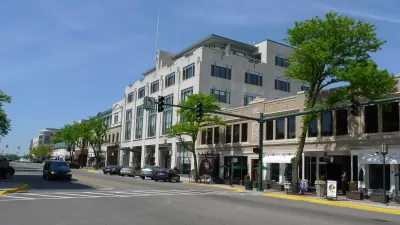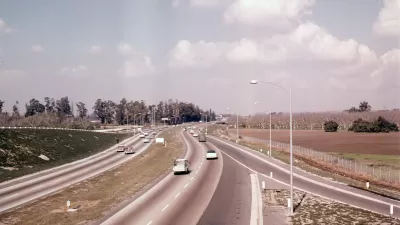It has been 20 years since the city of Birmingham, Michigan approved the Birmingham 2016 Master Plan. Robert J. Gibbs, one of the planners on a team that included Andrés Duany, describes the decisions and process that contributed to the plan.

Birmingham, Michigan has a history of innovative plans designed to create a beautiful, vibrant city. In the 1920s, its General Village Plan [pdf] created a central civic square bounded by a library, city hall, and post office. The 1960s brought a plan [pdf] to build five parking decks along Ring Road, which enclosed the downtown core and allowed high rises to be built. This resulted in more than 3 million square feet of new commercial buildings and a remarkably upscale downtown for a Midwest city of its small population of 20,000 people.
However, despite these apparent successes, citizen complaints led city officials to repeal permitted densities and limit new construction to a floor-area ratio of two [pdf], including the basement. This stalled new downtown development for two decades.
These decisions resulted in stagnant commercial growth, and decay began to consume Birmingham. By the 1990s, top retailers and commercial tenants had moved out. Ring Road, which was designed for high-speed traffic, cut off the city's downtown from its surrounding residential neighborhoods. The city's approval process grew cumbersome and time consuming. Plus, the city was dealing with a 20 percent population loss. Birmingham faced a crisis that could have decimated it.
In 1996 city officials decided to develop a new, 20-year master plan to address the situation. They selected a team of national and local planners and consultants led by the noted architect Andrés Duany, along with local planners Gibbs Planning Group, McKenna Associates, and The Green Group. This core planning team assembled 50 top architects, economists, planners, and engineers to address the challenges facing the city. Andrés Duany is known globally for his leadership with the plan and code for Seaside, Florida, the first new traditional community. He also works closely with Prince Charles and serves as a consultant for the Prince's Foundation for Building Community, planning new towns across the United Kingdom.
The Birmingham 2016 Master Plan began with three months of community educational and information-gathering sessions, culminating with a seven-day charrette in a downtown storefront. The intensive accommodation of public input was designed to develop community support for, and ownership of, the new plan. This level of public engagement was one of the most successful aspects of the plan, encouraging its members to reach agreement on the city's future size and character. More than 2,500 citizens, business and property owners, developers, elected officials, and others attended more than 70 meetings during the charrette. Real-time feedback was gathered and incorporated into the plan, alternatives for which were presented twice daily. The principles shared were so helpful and successful they continue to influence policy discussions 20 years later.

The decision was made to grow Birmingham from a town into a small city. The 2016 Master Plan reflected this desire by recommending numerous policy revisions, streetscape improvements, park expansions, traffic-calming measures, and the first form-based code in Michigan history. In fact, it was one of the first form-based codes implemented in the United States.
A form-based code utilizes the physical form of the structure, rather than being based on separation of uses, such as commercial, residential, etc. A form-based code offers a powerful alternative to conventional zoning regulation, and is adopted into city, town, or county law. The revolutionary aspect of form-based codes comes from their ability to address the relationship between building facades and the public realm as well as the form and mass of buildings in relation to one another. Form-based codes are integral to a regulating plan that designates the appropriate form and scale, and therefore the character, of development, rather than only distinctions in land-use types.
This allowed the team to create a plan that was based on market research and included a form-based overlay-zoning district, which prescribed building dimensions and placements, building forms and materials, and permitted uses. The city engineered and installed new techniques in urban traffic calming, without reducing vehicular capacity, and expanded sidewalks and permitted adjacent on-street parking to allow for outdoor dining. A public surface parking lot was converted into a park without losing a single stall.

Drawing courtesy of Duany Plater-Zyberk & Company.
The plan included ten park improvements; a civic square expansion; a traffic-calming boulevard; and specified an entirely new streetscape plan including lighting, benches, and paving. All fixtures and signage were painted "Birmingham Green,” which provided an improved and unified identity to the downtown.
With its new plan in place, Birmingham turned a corner during the 20 years that followed. Now, in 2016, more than 30 major, mixed-use buildings have been constructed, including a multi-screen regional cinema, and a new five-level Class-A office building and a luxury restaurant. Birmingham now has the highest commercial rents and land values in Michigan, and is considered one of the most walkable and commercially successful small towns in America.

Birmingham's success has been noticed. Many of the innovative principles and techniques developed for its 2016 Master Plan have been implemented in cities throughout the country. They have become the foundation for form-based codes, smart-growth codes, traffic-calming measures, and the public charrette planning process. The planning methods that were developed, tested, and proven during the Birmingham 2016 Master Plan process are now common best practices. Birmingham has become a model of urban excellence.
Robert Gibbs, AICP, ASLA, is founder and principal of Gibbs Planning Group in Birmingham, co-planner of the Birmingham 2016 Master Plan, and the author of Principles of Urban Retail Planning and Development.

Study: Maui’s Plan to Convert Vacation Rentals to Long-Term Housing Could Cause Nearly $1 Billion Economic Loss
The plan would reduce visitor accommodation by 25,% resulting in 1,900 jobs lost.

Alabama: Trump Terminates Settlements for Black Communities Harmed By Raw Sewage
Trump deemed the landmark civil rights agreement “illegal DEI and environmental justice policy.”

Why Should We Subsidize Public Transportation?
Many public transit agencies face financial stress due to rising costs, declining fare revenue, and declining subsidies. Transit advocates must provide a strong business case for increasing public transit funding.

Paris Bike Boom Leads to Steep Drop in Air Pollution
The French city’s air quality has improved dramatically in the past 20 years, coinciding with a growth in cycling.

Why Housing Costs More to Build in California Than in Texas
Hard costs like labor and materials combined with ‘soft’ costs such as permitting make building in the San Francisco Bay Area almost three times as costly as in Texas cities.

San Diego County Sees a Rise in Urban Coyotes
San Diego County experiences a rise in urban coyotes, as sightings become prevalent throughout its urban neighbourhoods and surrounding areas.
Urban Design for Planners 1: Software Tools
This six-course series explores essential urban design concepts using open source software and equips planners with the tools they need to participate fully in the urban design process.
Planning for Universal Design
Learn the tools for implementing Universal Design in planning regulations.
Smith Gee Studio
Alamo Area Metropolitan Planning Organization
City of Santa Clarita
Institute for Housing and Urban Development Studies (IHS)
City of Grandview
Harvard GSD Executive Education
Toledo-Lucas County Plan Commissions
Salt Lake City
NYU Wagner Graduate School of Public Service




























